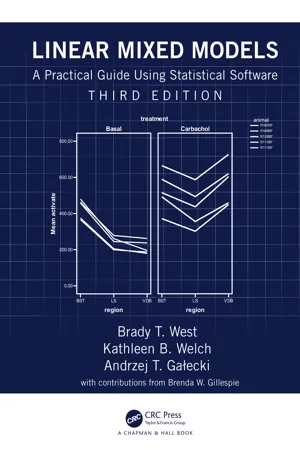
Linear Mixed Models
A Practical Guide Using Statistical Software
- 490 pages
- English
- ePUB (mobile friendly)
- Available on iOS & Android
Linear Mixed Models
A Practical Guide Using Statistical Software
About this book
Highly recommended by JASA, Technometrics, and other leading statistical journals, the first two editions of this bestseller showed how to easily perform complex linear mixed model (LMM) analyses via a variety of software programs. Linear Mixed Models: A Practical Guide Using Statistical Software, Third Edition continues to lead readers step-by-step through the process of fitting LMMs.
The third edition provides a comprehensive update of the available tools for fitting linear mixed-effects models in the newest versions of SAS, SPSS, R, Stata, and HLM. All examples have been updated, with a focus on new tools for visualization of results and interpretation. New conceptual and theoretical developments in mixed-effects modeling have been included, and there is a new chapter on power analysis for mixed-effects models.
Features: •Dedicates an entire chapter to the key theories underlying LMMs for clustered, longitudinal, and repeated measures data
•Provides descriptions, explanations, and examples of software code necessary to fit LMMs in SAS, SPSS, R, Stata, and HLM
•Contains detailed tables of estimates and results, allowing for easy comparisons across software procedures
•Presents step-by-step analyses of real-world data sets that arise from a variety of research settings and study designs, including hypothesis testing, interpretation of results, and model diagnostics
•Integrates software code in each chapter to compare the relative advantages and disadvantages of each package
•Supplemented by a website with software code, datasets, additional documents, and updates
Ideal for anyone who uses software for statistical modeling, this book eliminates the need to read multiple software-specific texts by covering the most popular software programs for fitting LMMs in one handy guide. The authors illustrate the models and methods through real-world examples that enable comparisons of model-fitting options and results across the software procedures.
Frequently asked questions
- Essential is ideal for learners and professionals who enjoy exploring a wide range of subjects. Access the Essential Library with 800,000+ trusted titles and best-sellers across business, personal growth, and the humanities. Includes unlimited reading time and Standard Read Aloud voice.
- Complete: Perfect for advanced learners and researchers needing full, unrestricted access. Unlock 1.4M+ books across hundreds of subjects, including academic and specialized titles. The Complete Plan also includes advanced features like Premium Read Aloud and Research Assistant.
Please note we cannot support devices running on iOS 13 and Android 7 or earlier. Learn more about using the app.
Information
Table of contents
- Cover
- Half Title
- Title Page
- Copyright Page
- Dedication
- Table of Contents
- Preface to the Third Edition
- Preface to the Second Edition
- Preface
- The Authors
- Acknowledgments
- List of Tables
- List of Figures
- 1 Introduction
- 2 Linear Mixed Models: An Overview
- 3 Two-Level Models for Clustered Data: The Rat Pup Example
- 4 Three-Level Models for Clustered Data: The Classroom Example
- 5 Models for Repeated-Measures Data: The Rat Brain Example
- 6 Random Coefficient Models for Longitudinal Data: The Autism Example
- 7 Models for Clustered Longitudinal Data: The Dental Veneer Example
- 8 Models for Data with Crossed Random Factors: The SAT Score Example
- 9 Power Analysis and Sample Size Calculations for Linear Mixed Models
- A Statistical Software Resources
- B Calculation of the Marginal Covariance Matrix
- C Acronyms / Abbreviations
- Bibliography
- Index